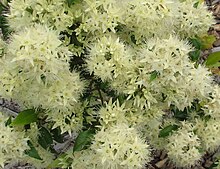Syzygium anisatum
| Syzygium anisatum | |
|---|---|

| |
| Flowers | |

| |
| Scientific classification | |
| Kingdom: | Plantae |
| Clade: | Tracheophytes |
| Clade: | Angiosperms |
| Clade: | Eudicots |
| Clade: | Rosids |
| Order: | Myrtales |
| Family: | Myrtaceae |
| Genus: | Syzygium |
| Species: | S. anisatum
|
| Binomial name | |
| Syzygium anisatum | |
| Synonyms[3] | |
| |
Syzygium anisatum, with common names ringwood and aniseed tree, is a rare rainforest tree native to New South Wales, Australia. The aromatic leaves contain an essential oil profile comparable to true aniseed.
The leaf from cultivated plantations is used as a bushfood spice and distilled for the essential oil, and is known in the trade as aniseed myrtle or anise myrtle.
The ringwood tree has a dense crown and grows up to 45 m (148 ft) tall. The leaves are 6–12 cm (2.4–4.7 in) long with prominently undulated margins and rich aniseed aroma when crushed.
Flowers are white and sweetly scented, borne in panicles. The fruit are dry papery capsules around 5 mm (0.20 in) long and are white in appearance.
Ringwood's natural distribution in the wild is restricted to the Nambucca and Bellinger Valleys in northeastern New South Wales.[4]
Uses
[edit]Used as a flavouring spice and herbal tea ingredient. Although previously known, it was first sold in the early 1990s as a bushfood spice, and in the mid 1990s cultivated in plantations to meet demand.[5][6]
The essential oil of S. anisatum contains anethole and methyl chavicol, imparting licorice and aniseed flavours respectively.
'Aniseed myrtle' is the name originally coined to specifically describe high quality selections of the trans-anethole chemotype (90%+) - generally recognized as safe for flavouring. These selections are propagated from cutting for consistent essential oil quality. The aniseed myrtle selections are also low in methyl chavicol and cis-anethole (less than 0.1%).
Research indicates that aniseed myrtle oil has antimicrobial activity, including on the pathogenic yeast Candida albicans.[7]
Myrtle rust
[edit]A significant fungal pathogen, myrtle rust (Austropuccinia), was detected in aniseed myrtle plantations in January 2011.[8] Myrtle rust severely damages new growth and threatens aniseed myrtle production. Controls are being developed.
See also
[edit]References
[edit]- ^ "Syzygium anisatum". Australian Plant Name Index (APNI). Centre for Australian National Biodiversity Research, Australian Government. Retrieved 13 February 2025.
- ^ Craven, L.A.; Biffin, E. (2005). "Anetholea anisata transferred to, and two new Australian taxa of, Syzygium (Myrtaceae)". Blumea. 50 (1): 157–162. doi:10.3767/000651905X623346.
- ^ "Syzygium anisatum (Vickery) Craven & Biffin". Plants of the World Online. Royal Botanic Gardens, Kew. 2025. Retrieved 13 February 2025.
- ^ Peter G.Wilson (2006). "Anetholea anisata (Vickery) Peter G.Wilson". PlantNET (The NSW Plant Information Network System). Royal Botanic Gardens and Domain Trust, Sydney. Retrieved 13 February 2025.
- ^ "Australian Native Foods - Industry Profile - Regions". CSIRO. Archived from the original on 18 March 2010. Retrieved 10 February 2012.
- ^ "Australian Native Foods - Industry Profile - Processors and Marketers". CSIRO. Archived from the original on 9 February 2008.
- ^ Wilkinson, Jenny M.; Cavanagh, M.A. (2005). "Antibacterial activity of essential oils from Australian native plants". Phytotherapy Research. 19 (7): 643–646. doi:10.1002/ptr.1716.
- ^ "Myrtle Rust - host list and images". Department of Primary Industries. New South Wales Government. Archived from the original on 16 February 2011.
External links
[edit]- View a map of herbarium records of this species at the Australasian Virtual Herbarium
- View observations of this species on iNaturalist
- See images of this species on Flickriver.com
